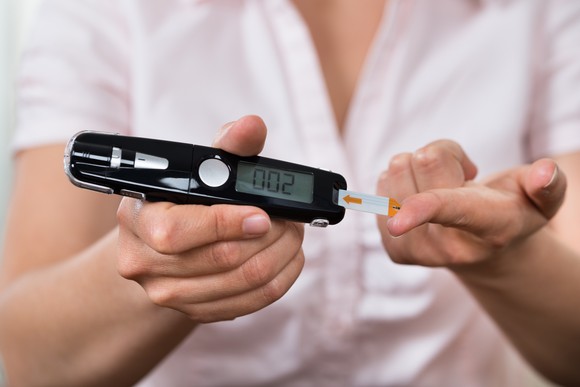It's officially earnings season, which can only mean one thing: Johnson & Johnson(NYSE:JNJ) is kicking things off for big pharmaceutical companies.
On Tuesday morning, July 18, Johnson & Johnson released its second-quarter earnings results, keeping alive a recent trend of better-than-expected profits and lower-than-anticipated sales.
Johnson & Johnson's second quarter, by the numbers
For the quarter, J&J, as the company is more commonly known, reported $18.84 billion in worldwide sales, which was a 1.9% increase from the prior-year quarter, or a 2.9% increase if we look at things on an apples-to-apples basis without currency fluctuations. By comparison, Wall Street had been looking for the company to deliver $18.97 billion in sales.

IMAGE SOURCE: GETTY IMAGES.
In terms of its bottom-line, J&J wound up reporting earnings per share of $1.83, besting Wall Street's consensus by $0.03 per share. J&J has topped the Street's EPS estimates in every quarter for more than three years. Further, it upped its full-year EPS forecast to a fresh range of $7.15 to $7.22 from a previous forecast of $7 to $7.15. J&J has historically been conservative with its full-year profit guidance, so this isn't a big surprise.
While it's not shocking that Wall Street and investors have chosen to focus on J&J's headlines figures, these don't even come close to telling the full story of Johnson & Johnson's second quarter. Here are five off-the-radar figures you may not have paid attention to that are far more telling.
1. U.S. pharmaceutical sales: minus 2.6%
On a worldwide operating basis, excluding currency fluctuations, J&J's pharmaceutical segment, which is its primary source of growth and juicy margins, grew by 1%. However, this growth was entirely due to an increase in sales in overseas markets. Within the U.S., pharmaceutical sales fell 2.6%. As a whole, worldwide pharmaceutical revenue accounted for nearly 46% of total sales in the second quarter.
Why are pharma sales struggling? We're going to get into a bit more detail in the points to follow, but the short and sweet answer is that mature drugs are facing increasing competition from generics, biosimilar drugs, and new brand-name therapeutics.
Weakness in domestic pharmaceutical sales is a big reason why J&J has been active on the acquisition front. Normally known for its small- and mid-cap acquisitions, J&J completed its purchase of Swiss-based specialty drugmaker Actelion this past quarter for $30 billion in cash. J&J's management is counting on sales growth from Actelion's pulmonary arterial hypertension drugs to counteract weakness from the company's mature drug portfolio.

IMAGE SOURCE: GETTY IMAGES.
2. U.S. Remicade sales: minus 13.9%
Building on the first point, one of the biggest hits to J&J's domestic pharmaceutical sales was anti-inflammatory drug Remicade. During the quarter, sales of the drug fell worldwide by 13.6% on an operating basis to $1.53 billion, but tumbled 13.9% within the United States to $1.06 billion.
Why the sudden plunge in J&J's best-selling drug? Don't look to generic competition. Instead, point the blame at the introduction of Inflectra, a biosimilar drug (essentially a copycat version of a biologic drug) that Celltrion licensed out to Pfizer (NYSE:PFE). Pfizer brought Inflectra to market last November at a 15% discount to Remicade's list price, and while the initial reaction to J&J's top-line on Remicade was minimal in the first quarter, we're beginning to see a major impact to sales. With comparable efficacy, physicians and consumers appear to be choosing Inflectra over Remicade, leaving J&J's management with a tough choice on whether or not it should lower its list price to match Inflectra.
For the time being, shareholders should expect worldwide Remicade sales to continue to weaken.

IMAGE SOURCE: GETTY IMAGES.
3. U.S. Invokana sales: minus 26.4%
Arguably an even greater disappointment than Remicade's double-digit domestic sales decline is the continued weakness in type 2 diabetes drug Invokana. Even though international sales of the drug grew by $4 million to $39 million in the second quarter, domestic sales plunged 26.4% to $256 million. For the year, Invokana sales are lower by 22% in the U.S.
What's going on with Invokana? Considering that sales have plunged for two consecutive quarters, I believe we can cross inventory issues off the list. This appears to be more a function of growing competition in the SGLT-2 inhibitor space, as well as recently released data from J&J concerning its lead diabetes medicine.
For those who may not recall, even though J&J reported positive long-term cardiovascular results in its CANVAS and CANVAS-R studies involving Invokana, some of which trumped that of Eli Lilly's and Boehringer Ingelheim's SGLT-2 inhibitor Jardiance, Invokana also led to an increased risk of foot and leg amputations in two separate long-term studies. Lilly's and Boehringer's potentially safer diabetes drug, along with other SGLT-2 inhibitors, may very well be poaching sales from Invokana.

IMAGE SOURCE: GETTY IMAGES.
4. Darzalex sales: up 176.9%
On the other hand, Johnson & Johnson's second-quarter report also delivered stellar figures from the company's oncology segment. In particular, multiple myeloma drug Darzalex and blood cancer drug Imbruvica were standouts.
For the quarter, worldwide sales of Darzalex rose by a blistering 177% to $299 million, and now stand at $554 million through the first six months of the year. Based on these figures, Darzalex is well on its way to topping $1.1 billion in sales for the year, conservatively. Even more interesting, Darzalex is just scratching the tip of the iceberg in terms of its label expansion opportunities within multiple myeloma and other cancer types.
Similarly consistent growth was seen from Imbruvica, where revenue is split between J&J and AbbVie, which acquired Pharmacyclics, the company that discovered Imbruvica, in 2015. Quarterly sales on J&J's end vaulted to $450 million worldwide, a 55% increase on an operating basis.
Long story short, oncology remains a saving grace for J&J's pharma segment at present.

IMAGE SOURCE: GETTY IMAGES.
5. Litigation expenses: minus 17.8%
Last, but not least, take note of J&J's litigation expenses during the second quarter, as well as year-to-date. Though litigation expenses are generally lumpy for large companies like J&J, litigation expenses as a whole fell $107 million (17.8%) during the second quarter from the prior-year period, and $173 million on year-to-date basis.
On the surface, lower litigation expenses are great news because it should mean higher margins and profits for J&J. But, there's more to it than this. Falling litigation expenses also implies, at least to this Fool, that J&J's occasional PR flubs are successfully being put into the rearview mirror. Lawsuits against the company concerning talc-based ovarian cancers and faulty hip implants appear to have had only very short-term impacts on J&J's sales and brand-image.
The bottom line
What we have with J&J's second-quarter report is another par-for-the-course quarter. With the exception of the steepness in Invokana's and Remicade's sales declines, nothing was that particularly surprising. The addition of Actelion's specialty drug portfolio and Abbott Medical Optics should help right the ship for J&J's pharma and vision care segments. Ultimately, there were no red flags that should worry investors who are in J&J for the long term.
The big question that remains is what's on J&J's acquisition radar next? Will it return to its strategy of acquiring smaller pharmaceutical companies and licensing first-in-class therapies, or is another Actelion-sized purchase on the horizon? Only time will tell.
10 stocks we like better than Johnson & Johnson
When investing geniuses David and Tom Gardner have a stock tip, it can pay to listen. After all, the newsletter they have run for over a decade, Motley Fool Stock Advisor, has tripled the market.*
David and Tom just revealed what they believe are the ten best stocks for investors to buy right now... and Johnson & Johnson wasn't one of them! That's right -- they think these 10 stocks are even better buys.


